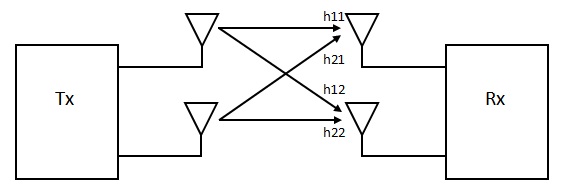As discussed previously building an LTE fading simulator is a three step procedure.
1. Generate a temporally correlated Rayleigh fading sequence. This step would be repeated for each channel tap and transmit receive antenna combination e.g. for a 2×2 MIMO system and EPA channel model with 7 taps the number of fading sequences to be generated is 4×7=28. The temporal correlation of these fading sequences is controlled by the Doppler frequency. A higher Doppler frequency results in faster channel variations and vice versa.
2. Introduce spatial correlation between the parallel paths e.g. for a 2×2 MIMO system a 4×4 antenna corelation matrix would be used to introduce spatial correlation between the 4 parallel paths h11, h12, h21 and h22. This can be thought of as a weighted average. A channel coefficient between Tx-1 and Rx-1 would be calculated as h11=w1*h11+w2*h12+w3*h21+w4*h22. In this case the weight ‘w1’ would have a value of 1 whereas the other weights would have a value less than 1. If w2=w3=w4=0 there is no correlation between h11 and other channel coefficients.
3. Once the sequences with the desired temporal and spatial correlation have been generated their mean power would have to be adjusted according to the power delay profile of the selected channel model (EPA, EVA or ETU). The number of channel coefficients increases exponentially with the number of transmit and receiver antennas e.g. for a 4×4 MIMO system each filter tap would have to be calculated after performing a weighted average of 16 different channel taps. And this step would have to be repeated for each filter tap resulting in a total of 16×7=112 fading sequences.
We have already discussed step 1 in detail. We would now elaborate on step 2 i.e. generation of spatially correlated fading sequences.
Author: Yasir
More than 20 years of experience in various organizations in Pakistan, the USA, and Europe. Worked with the Mobile and Portable Radio Group (MPRG) of Virginia Tech and Qualcomm USA and was one of the first researchers to propose Space Time Block Codes for eight transmit antennas. Have publsihed a book “Recipes for Communication and Signal Processing” through Springer Nature.
